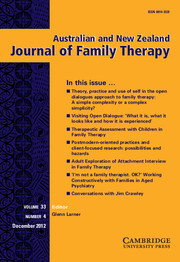Crossref Citations
This article has been cited by the following publications. This list is generated based on data provided by
Crossref.
MacKay, Linda
and
Brown, Jenny
2013.
Collaborative Approaches to Family Systems Supervision: Differentiation of Self.
Australian and New Zealand Journal of Family Therapy,
Vol. 34,
Issue. 4,
p.
325.
McIlwaine, Fiona
and
O'Sullivan, Kerry
2015.
‘Riding the Wave’: Working Systemically with Traumatised Families.
Australian and New Zealand Journal of Family Therapy,
Vol. 36,
Issue. 3,
p.
310.
Hisle-Gorman, Elizabeth
Harrington, Donna
Nylund, Cade M.
Tercyak, Kenneth P.
Anthony, Bruno J.
and
Gorman, Gregory H.
2015.
Impact of Parents’ Wartime Military Deployment and Injury on Young Children’s Safety and Mental Health.
Journal of the American Academy of Child & Adolescent Psychiatry,
Vol. 54,
Issue. 4,
p.
294.
MacKay, Linda M.
2017.
Differentiation of Self: Enhancing Therapist Resilience When Working with Relational Trauma.
Australian and New Zealand Journal of Family Therapy,
Vol. 38,
Issue. 4,
p.
637.
Ennaco, Daniel T.
2018.
Encyclopedia of Couple and Family Therapy.
p.
1.
Ennaco, Daniel T.
2019.
Encyclopedia of Couple and Family Therapy.
p.
1090.
Henschel, Sébastien
Doba, Karyn
and
Nandrino, Jean-Louis
2019.
Emotion Regulation Processes and Psychoform and Somatoform Dissociation in Adolescents and Young Adults with Cumulative Maltreatment.
Journal of Trauma & Dissociation,
Vol. 20,
Issue. 2,
p.
197.
BRİDGE, Esra Nihan
2019.
Review of A Case Study in Light of Bowen Theory: Differentiation of Self.
Yaşam Becerileri Psikoloji Dergisi,
Vol. 3,
Issue. 5,
p.
65.
YILDIRIM, Buğra
2020.
SOSYAL HİZMET UYGULAMASINDA BOWEN'IN AİLE SİSTEMLERİ YAKLAŞIMI.
Sosyal Politika Çalışmaları Dergisi,
Vol. 20,
Issue. 47,
p.
287.
Hee, Cameron W. H.
Banford Witting, Alyssa
and
Sandberg, Jonathan G.
2021.
Family Adversity and Relationship Quality for Pacific Islanders and the Mediating Role of Coming to Terms, Self‐Esteem, and Depression.
Journal of Marital and Family Therapy,
Vol. 47,
Issue. 3,
p.
713.
Acquarini, Elena
2021.
Riflesso della menzogna nella transgenerazionalità.
Linguæ & - Rivista di lingue e culture moderne,
Vol. 20,
Issue. 2,
Guo, Xiamei
Huang, Jingwen
and
Yang, Yuexia
2022.
The Association between Differentiation of Self and Life Satisfaction among Chinese Emerging Adults: The Mediating Effect of Hope and Coping Strategies and the Moderating Effect of Child Maltreatment History.
International Journal of Environmental Research and Public Health,
Vol. 19,
Issue. 12,
p.
7106.
Enokela, Abel Ebiega
2022.
Impact of School Shootings on Classroom Culture, Curriculum, and Learning.
p.
140.
Petion, Ashlei R.
Chang, Catherine Y.
Brown‐Thompson, Crystal
Mitchell, Michelle D.
Grinnage, Deaetta
and
Huffstead, Mary E.
2023.
“Battling something bigger than me”: A phenomenological investigation of generational trauma in African American women.
Journal of Counseling & Development,
Vol. 101,
Issue. 1,
p.
69.




